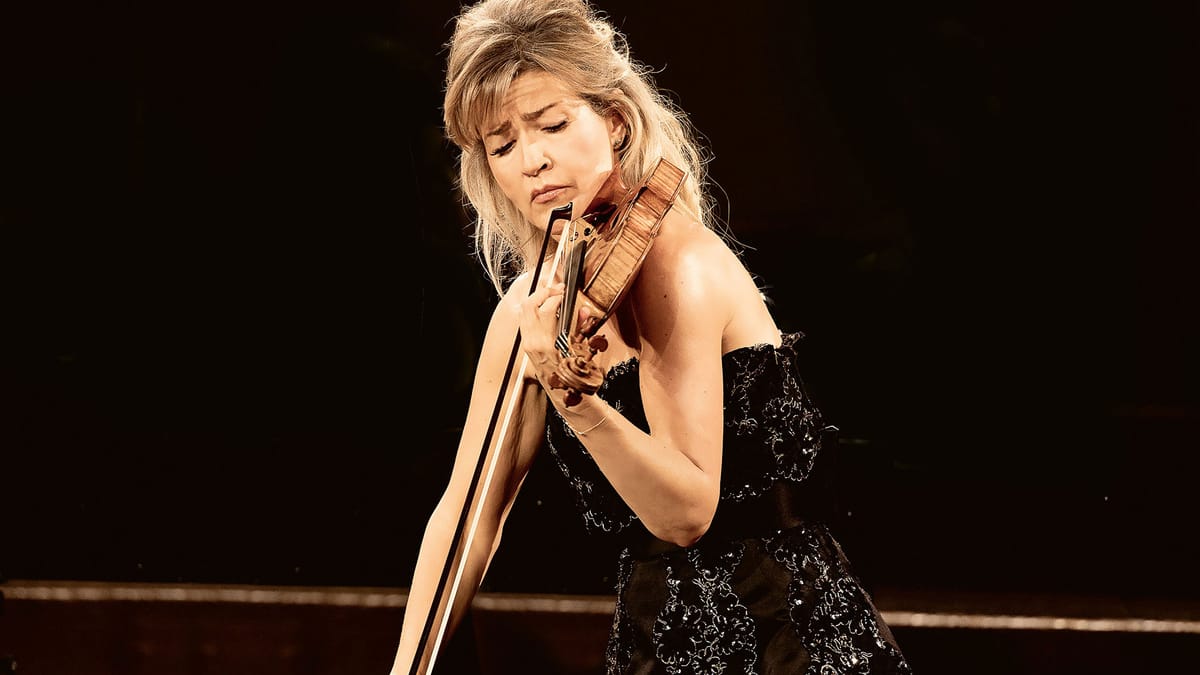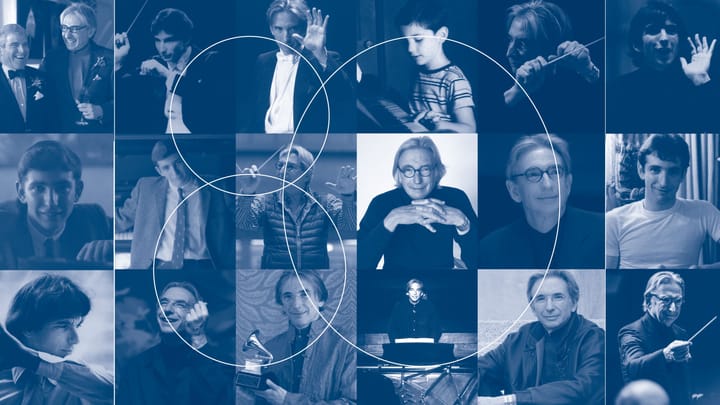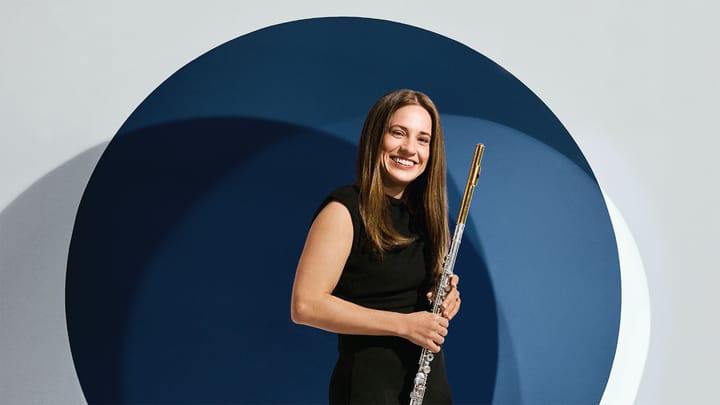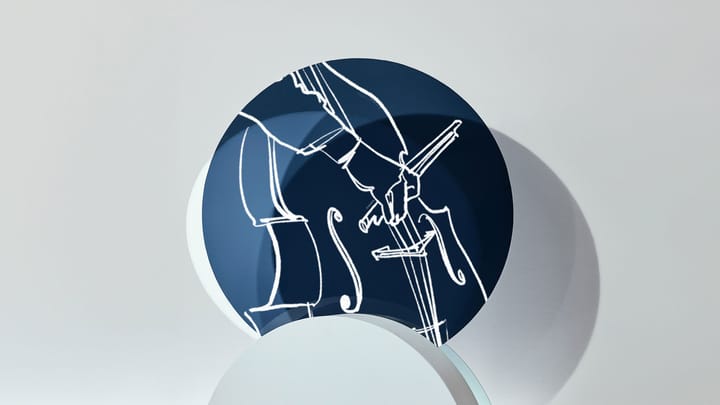In This Program
The Concert
Sunday, April 6, 2025, at 7:30pm
Anne-Sophie Mutter violin
Lambert Orkis piano
Wolfgang Amadeus Mozart
Violin Sonata No. 18 in G major, K.301 (1778)
Allegro con spirito
Allegro
Franz Schubert
Fantasy in C major, D.934 (1827)
Andante molto–
Allegretto–
Andantino–
Allegro vivace–Presto
Intermission
Clara Schumann
Three Romances, Opus 22 (1853)
Andante molto
Allegretto
Leidenschaftlich schnell (Passionately fast)
Aftab Darvishi
Likoo (2024)
Commissioned by Anne-Sophie Mutter
Ottorino Respighi
Violin Sonata in B minor (1917)
Moderato
Andante espressivo
Passacaglia: Allegro moderato ma energico
This performance is supported by the Wattis Special Performance Fund.
Presenting Sponsor of the Great Performers Series

This concert is generously sponsored by the Athena T. Blackburn Endowed Fund for Russian Music.
Program Notes
Violin Sonata No. 18 in G major, K.301
Wolfgang Amadeus Mozart
Born: January 27, 1756, in Salzburg
Died: December 5, 1791, in Vienna
Work Composed: 1778
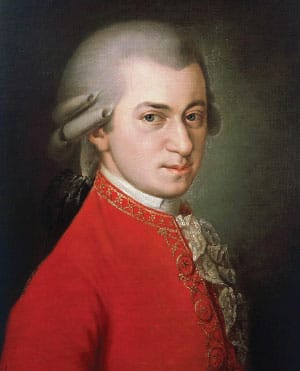
Given his dual skill as a keyboardist and an adept violinist, Mozart was perfectly positioned to champion the “sonata for pianoforte with violin accompaniment,” as it was typically expressed when the genre emerged in the second half of the 18th century. As that wording suggests, the piano was generally the dominant partner in these works and the violin the accompaniment, but Mozart explored how the two instruments might prove mutually enriching to each other, and he developed his insights through 33 sonatas for piano and violin from about 1764 until 1788.
Midway through this production we encounter his six Palatine sonatas, so called because when they were published, by the Parisian firm of Siebert in November 1778, they bore a dedication to the Electress of the Palatinate. Mozart wrote four of them (K.301–303 and K.305) in Mannheim, the capital of the Palatinate, where he spent four-and-a-half months beginning on October 30, 1777; the G-major sonata probably dates from February 1778. The 21-year-old composer, having just broken free from restrictive employment in his native Salzburg, hoped to find employment in Mannheim, where the Palatine court had assembled one of the great cosmopolitan orchestras of Europe. No appointment was forthcoming, but at least he picked up some commissions, hobnobbed with famous musicians, and became acquainted with the Weber family, a daughter of which would become his wife five years later.
Uniquely for the Palatine set, Mozart notes on the manuscript for this G-major sonata that the accompanying part is for violin or flute, and in places he provides separate lines to respect the different ranges of those instruments. In Mannheim, Mozart had been commissioned by Ferdinand Dejean, an accomplished amateur flutist, to write some concertos and chamber works for him; the idea to make this sonata adaptable for the flute very likely grew from that, but it proved musically problematic. Mozart deleted the alternative flute lines, and that instrument was not mentioned when the sonata was published. As with five of the six Palatine sonatas, this one consists of only two movements, a common layout for sonatas at that time (say, by Haydn or J.C. Bach), but unusual for Mozart. The first movement is in sonata form, while the second is structured A-B-A, as if it might grow into a proper rondo.
Fantasy in C major, D.934
Franz Schubert
Born: January 31, 1797, in Vienna
Died: November 19, 1828, in Vienna
Work Composed: 1827
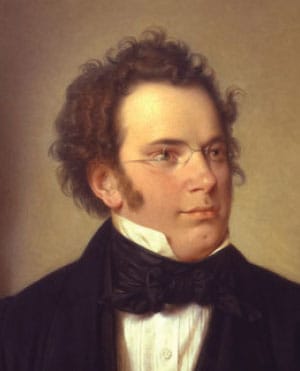
The most imposing of Franz Schubert’s six works to spotlight the violin is the Fantasy in C major, written at the end of 1827, almost surely for Josef Slavík, a Czech violinist who moved to Vienna in 1826 and created a sensation at his debut recital there that April; he premiered it, with pianist Karl Maria von Bocklet, at a midday recital on January 20, 1828, at Vienna’s Landhaussaal. Schubert did not see the piece in print by the time he died that November. In fact, it was not published until 1850, when the Viennese firm of A. Diabelli & Co. finally brought it out, attaching to it the opus number 159. Its contemporaries in Schubert’s output include such masterworks of 1827 as the song cycle Winterreise (composed from February through October), his two piano trios (both of which date from that year), and the Four Impromptus for Piano (D.935, written the same month as the Fantasy).
Schubert seems intent here on stressing virtuosity a shade more than is his wont. This full-scale work is divided into four principal sections, with the last escalating at its end into a super-fast coda (Presto). Reviewing the premiere, the newspaper Sammler observed:
The Fantasia . . . occupied rather too much of the time a Viennese is prepared to devote to the pleasures of the mind. The hall emptied gradually, and the writer confesses that he too is unable to say anything about the conclusion of this piece of music.
Two other reviews were similarly unenthusiastic, but a correspondent to London’s Harmonicon was more positive, remarking, “A new Fantasia, for the pianoforte and violin, from the pen of Franz Schubert possesses merit far above the common order.” Probably the most memorable expanse is the set of variations at the work’s center, its theme being an alteration of the song “Sei mir gegrüsst,” which Schubert had probably composed in 1822 to a poem by Friedrich Rückert and that had gained great popularity. (Oddly, Schubert also seemed to have had on his mind Mozart’s A-major Piano Sonata, K.331, a phrase of which dovetails with the song’s melody.) After working through sections of escalating bravura, the music here resolves into a more lyrical variation and then a swaggering finale, into which “Sei mir gegrüsst” injects its voice one last time near the end.
Three Romances, Opus 22
Clara Schumann
Born: September 13, 1819, in Leipzig
Died: May 20, 1896, in Frankfurt am Main
Work Composed: 1853
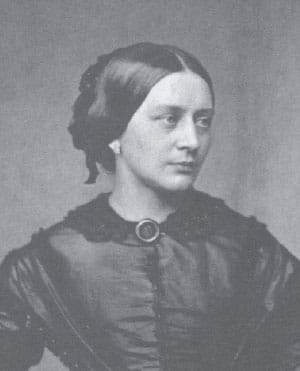
Clara Wieck was famously the daughter of the distinguished piano teacher Friedrich Wieck, but it is less often mentioned that her mother’s side was also musical. Her mother had been a pupil of Friedrich’s before they married, and Clara’s maternal great-grandfather was the flutist and instrument-builder Johann George Tromlitz, author of a monumental flute treatise. After her parents divorced in 1824, Clara remained with her father. He prepared her for her concert debut at the Leipzig Gewandhaus in 1828, at the age of nine, and she published her first compositions—a set of polonaises—three years later. By 1832 she was thinking about writing a piano concerto, discussing her plan with one of her father’s pupils who had lived in the family home for the past two years, a certain Robert Schumann. Love did not complicate their friendship until 1835. They married in September 1840, on the day before her 21st birthday, after leaping many hurdles to overcome her father’s strenuous objections.
She continued appearing as a pianist through most of their marriage and on into her old age, championing her husband’s music, new works by friends like Mendelssohn and Brahms, and classics by Bach and Beethoven. Such a career would be challenging enough on its own, but from 1841 to 1854 she also had eight children, seven of whom survived infancy. She all but abandoned composition after 1856, the year Robert died in the asylum where he had been confined for two-and-a-half years. Her opus numbers reached only to 23, including songs, piano solos, a piano concerto, an exemplary piano trio, and the Three Romances for violin and piano.
She composed the Romances for Joseph Joachim, a close friend and frequent concert companion, the two appearing in at least 238 joint concerts through the years. On hearing him perform Beethoven’s violin concerto in 1853, she wrote that he played “with a finish, a depth of poetic feeling, his whole soul in every note, so ideally, that I have never heard violin-playing like it, and I can truly say that I have never received so indelible an impression from any virtuoso.” They first worked together in May 1853, at the Lower Rhine Music Festival, and in July she produced these three enchanting Romances, her only compositions for violin and piano—an expressive and flowing slow movement, an imaginative Allegretto in a story-telling mode, and an ardent finale that is marked “passionately fast.”
Likoo
Aftab Darvishi
Born: July 21, 1987, in Tehran
Work Composed: 2024

Growing up in Iran, Aftab Darvishi began violin lessons at the age of five. She later studied piano and kamancheh (a bowed string instrument of Central Asia; its name means “little bow” in Persian), but as a mature composer she says that she is motivated by “various combinations of vocals, which have been a constant source of inspiration throughout my musical journey.” She graduated with honors in music performance from the University of Tehran (which she continues to visit as a guest lecturer), earned a master’s in film composition from the Amsterdam Conservatory, completed composition studies at the Royal Conservatory of The Hague, and is pursuing the PhD in composition at the University of Birmingham.
In 2019, her opera Turan Dokht (a collaboration with director Miranda Lakerveld) premiered at the Holland Festival; meaning “Turan’s Daughter,” it references the Persian origins of the story that evolved into Puccini’s Turandot. In 2022, Darvishi released her debut album A Thousand Butterflies, a portrait album that, she says, “evokes a life that has crossed continents.”
She composed Likoo, a five-minute work for unaccompanied violin, in 2024, on commission from Anne-Sophie Mutter, who presented its premiere just three days ago, on April 3, at Carnegie Hall. Darvishi provided this comment about the piece:
Likoo is one of the most important mughams [modal systems that combine classical poetry and musical improvisation] from the Baluchistan province of Iran, a region located in the southeast of the country, bordering Pakistan and Afghanistan. Traditionally, Likoo is performed with instruments such as the gheychak (a bowed lute) or donali (a pair of fipple flutes), often accompanied by a singer. These songs typically are about grief and longing for a loved one.
This piece reflects deep longing, specifically for those lost since the onset of the Women, Life, Freedom movement in Iran in September 2022. During this time, many mothers have lost their children, lovers have been torn apart, and many have fled their homeland. While loss may take on different meaning for each person, I explore its various dimensions in this piece. While the direct presence of Likoo might not be evident in this piece, its essence and aesthetics serve as the inspiration for the composition. The piece is dedicated to one of the greatest musical figures of our time, Anne-Sophie Mutter, and to all the women who continue to mourn the loss of a loved one.
Violin Sonata in B minor
Ottorino Respighi
Born: July 9, 1879, in Bologna, Italy
Died: April 18, 1936, in Rome
Work Composed: 1917
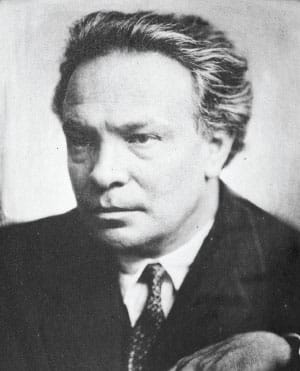
Following music study in his native Bologna, Ottorino Respighi worked as an orchestral viola player in Russia, where he studied with Nicolai Rimsky-Korsakov. Further work ensued with Max Bruch in Berlin, after which he returned to Italy to make his mark. Within a few years he was appointed composition professor at the Liceo di Santa Cecilia in Rome. Notwithstanding occasional episodes of enthusiasm for modernist developments, he settled into an essentially conservative stance as a composer. He would acquire fame thanks to his colorful symphonic works, beginning with his tone poem quadriptych Fountains of Rome, a failure at its 1917 premiere but a triumph when Toscanini led it the following year, and his first suite of Ancient Airs and Dances, hailed from its first performance in December 1917. Chamber music was never a prominent thread of his work, although he did compose a number of pieces for various ensembles around the turn of the century. His violin sonata is therefore rather an outlier in his oeuvre.
He dedicated the piece jointly to violinist Arrigo Serato and pianist Ernesto Consolo, but it was premiered instead by violinist Federico Sarti, the composer’s former violin teacher, with Respighi himself as pianist, on March 3, 1918. The work’s generally dark countenance may relate to the fact that Respighi was mourning his adored mother, who died in March 1916. The loss sent him spiraling into his own health crisis—“neurasthenia,” according to a memoir by his soon-to-be wife. “Black, melancholy moods and a horrible feeling of solitude,” he wrote to a singer friend, but he forged on with his sonata. This is at heart a work in the Romantic tradition, its chromatic harmonies spiced with touches of Debussian modernity. The movements are bound together by Respighi’s take on the thematic transformation adopted by César Franck and his disciples, not in the sense that entire themes are repurposed from movement to movement but rather through small-scale motifs that resurface throughout the sonata. The brooding, sometimes stormy first movement has a hint of Brahms about it, and the second travels a vast emotional terrain, serene at the beginning and end, wildly passionate in the middle. Respighi’s penchant for early music (as in Ancient Airs and Dances) inhabits his finale, built on the Baroque variation form of the passacaglia. After the piano states the theme, which recalls the progression that fuels Bach’s C-minor Organ Passacaglia (BWV 582), the movement proceeds through 18 connected variations (plus coda) of wildly fluctuating character.
—James M. Keller
About the Artists
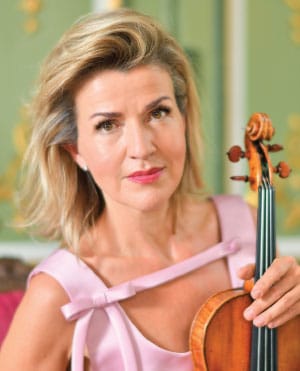
Anne-Sophie Mutter
For nearly five decades, the four-time Grammy Award–winner Anne-Sophie Mutter has been a fixture in the world’s major concert halls, making her mark on the world as a soloist, mentor, collaborator, humanitarian, and visionary artist.
Dedicated to supporting young musicians, Mutter founded the Association of Friends of the Anne-Sophie Mutter Foundation in 1997, to which the Anne-Sophie Mutter Foundation was added in 2008. Since 2011, Mutter has regularly shared the spotlight on stage with her ensemble of fellows known as Mutter Virtuosi.
Mutter’s 2025 season includes this US recital tour, which marks her 37th year collaborating with pianist Lambert Orkis. She also performs John Williams’s Second Violin Concerto with the Royal Philharmonic; appears with the Sofia Philharmonia and Staatskapelle Berlin; and performs in a trio with pianist Yefim Bronfman and cellist Pablo Ferrández.
Mutter has been recognized around the world for her contribution to the arts, culture, social causes, and leadership. She has been awarded the German Grand Cross of the Order of Merit, the French Medal of the Legion of Honor, the Bavarian Order of Merit, the Decoration of Honor for Services to the Republic of Austria, and numerous other honors. Most recently, the Krzysztof Penderecki Academy of Music bestowed an honorary doctorate upon her in 2022, and in 2023, she received the Ruhr Piano Festival Prize and was awarded a Gold Medal from the Royal Philharmonic Society. She made her San Francisco Symphony debut in 1988 as a Shenson Young Artist and was an artist in residence in 2019–20.
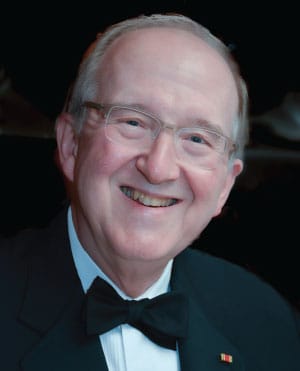
Lambert Orkis
Lambert Orkis has appeared in recital with Anne-Sophie Mutter since 1988 and also performed with Mstislav Rostropovich for more than 11 years. A Grammy Award winner and multi-Grammy Award nominee, Orkis’s wide discography includes works of the Classical, Romantic, and modern eras on many labels. With Mutter, he has frequently recorded for Deutsche Grammophon, winning a Grammy Award for Best Chamber Music Performance and a 2006 Choc de l’année award.
Orkis is a founding member of the Kennedy Center Chamber Players and the Smithsonian Institution’s Castle Trio, and holds the positions of principal keyboard of the National Symphony in Washington, DC, and professor of piano at Temple University in Philadelphia. He made his debut at the San Francisco Symphony in 1998 and owes much of his musical life to the guidance of Maryan Filar and the legendary Eleanor Sokoloff.

